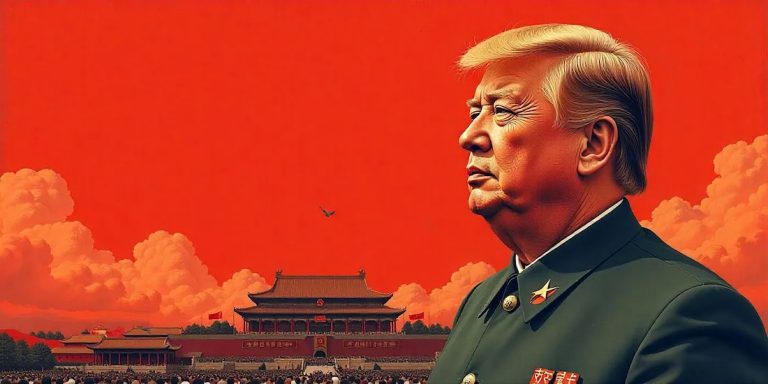
Trump’s relentless campaign against mainstream media—branding journalists as “the enemy of the people”—mirrors the way Mao used the Red Guards to purge intellectuals and rewrite historical narratives.
New York, N.Y. — Donald Trump’s political movement, described as a “second cultural revolution,” bears striking similarities to Mao Zedong’s campaign in China, with its authoritarian reshaping of institutions and values.
However, this transformation appears to follow a script: the Heritage Foundation’s Project 2025. Despite Trump publicly distancing himself from the initiative, its radical blueprint for dismantling the administrative state aligns closely with his policies and rhetoric.
Project 2025: Blueprint for Transformation
Project 2025, a 900-page conservative policy guide, outlines sweeping changes to federal agencies, including mass personnel replacements, dismantling departments like Education, and rolling back climate and social policies.
While Vice President Kamala Harris repeatedly warned of its dangers—calling it a roadmap for cutting Social Security and undermining healthcare protections—the American public was too liberal and naïve to truly grasp its existential threat.
The Heritage Foundation frames the project as empowering citizens and restoring government efficiency. Yet critics argue it mirrors Maoist tactics of ideological purges and institutional control. The plan’s emphasis on loyalty, rapid policy shifts, and centralization resonates with Trump’s governance style.
Parallels to Mao’s Cultural Revolution
Trump’s movement reflects Mao’s strategy of mass mobilization and institutional upheaval. Like Mao’s Red Guards, Trump’s loyalists—including right-wing militias and tech allies like Elon Musk—act as enforcers of his vision.
Musk’s Department of Government Efficiency (DOGE) initiative, which aims to slash $1 trillion in federal spending, has already caused disruptions in Social Security services and FEMA operations, echoing the chaos of Maoist reforms.
Mao’s Cultural Revolution (1966–1976) was a radical movement designed to purge capitalist influences and enforce ideological purity. It relied on mass mobilization, propaganda, suppression of intellectuals, and the dismantling of traditional institutions.
Trump’s America is not China, but his movement exhibits striking similarities: an authoritarian approach to loyalty, a relentless attack on dissent, and a systematic effort to bend institutions—including the judiciary, media, and education—to his will.
A War on Institutions and Truth
Mao’s Cultural Revolution turned schools, universities, and state media into ideological battlegrounds, silencing dissenting voices and enforcing loyalty. In Trump’s America, we see a parallel attack on institutions meant to uphold democracy.
Trump’s relentless campaign against mainstream media—branding journalists as “the enemy of the people”—mirrors the way Mao used the Red Guards to purge intellectuals and rewrite historical narratives.
Book bans, the gutting of DEI (Diversity, Equity, and Inclusion) programs, and the push to reshape history curricula to fit a nationalist, Trumpist narrative resemble the ways Mao sought to control education and suppress alternative viewpoints.
Similarly, Trump’s influence over the Republican Party has turned it into a vehicle of ideological purity, much like Mao’s Communist Party. Dissent is met with political exile, as seen in the fate of figures like Liz Cheney and Adam Kinzinger, who were ousted for failing to embrace Trump’s election lies.
The Judiciary and the Cult of Personality
A key feature of authoritarian revolutions is the takeover of the legal system to consolidate power. Trump and his allies have worked relentlessly to reshape the judiciary, stacking courts with loyalists who will rule in his favor.
His legal battles—ranging from his efforts to overturn the 2020 election to multiple criminal indictments—have been reframed as evidence of a corrupt “deep state” targeting him, further fueling his supporters’ belief that he alone represents justice.
Mao’s Cultural Revolution was deeply tied to his cult of personality, with citizens expected to worship his every word. Trump’s movement operates on a similar foundation.
His supporters view him not just as a politician, but as a messianic figure fighting a corrupt system. He alone, they believe, can “save America.” This kind of devotion creates an environment where democracy becomes secondary to loyalty.
Mass Mobilization and the Threat of Violence
Mao’s movement encouraged mass mobilization, often descending into violent purges. While Trump’s revolution has not reached the same level of organized violence, his rhetoric has inspired real-world action, from the January 6th insurrection to stochastic terrorism against perceived enemies.
His supporters—like Mao’s Red Guards—include militias, conspiracy theorists, and right-wing extremists who view themselves as enforcers of his vision. The rise in political violence, including threats against election officials and judges, echoes the chaos Mao’s ideological purges inflicted on China.
A Nation at a Crossroads
Trump’s second cultural revolution is not just a political movement; it is a fundamental reshaping of America’s civic and cultural identity. Like Mao’s campaign, it seeks to control the narrative, eliminate opposition, and install a new ideological order that erases traditional democratic norms.
The question now is whether America will resist this revolution or succumb to it.
In China, the Cultural Revolution ultimately led to devastation, economic collapse, and social trauma. Will the United States learn from history, or repeat its darkest chapters?
Kamala Harris’ Missed Warning
Harris attempted to spotlight Project 2025 as a harbinger of authoritarianism but struggled to galvanize public attention. Her warnings were dismissed as partisan fearmongering, overshadowing legitimate concerns about the erosion of democratic norms.
A Nation at Risk
If Trump’s administration continues along this path, guided by Project 2025, America risks deep societal fractures akin to those left by Mao’s revolution. The question remains whether the U.S. can resist this transformation or succumb to it — rewriting its democratic legacy in the process.
Trump’s Second Cultural Revolution: Scripted from Project 2025 (March 30, 2025)